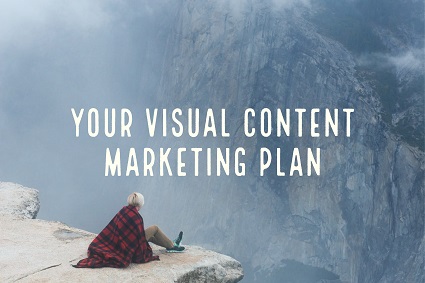A great content marketing strategy usually relies primarily on text. You identify the problems your target market faces, identify the keywords they’ll use to search for solutions, and create pages and posts that use those keywords to answer their questions. Do you also need a visual content marketing plan?
If you’re creating visual content — infographics, video, even white papers and ebooks — then you need a visual content marketing plan. You’re putting an investment of time and money into your graphics and visual assets, so you want to make sure that you get the best ROI for that investment.
“Content” is the operative word
We’re not talking here about branded illustrations for a blog post or decorative flourishes on a white paper. We’re talking about actual visual content, where the information is presented in a visual fashion. Consider the infographic below. It’s a fun way to share an idea.

Since this is a graphic, search engines won’t read the words or use the information in the picture to decide which searchers to show this to. From the point of view of human visitors, this is informative, entertaining content. From the point of view of search engines, it really isn’t.
That’s why your visual content marketing plan needs to be different from your overall content marketing plan.
Start by identifying the keywords you’ll use and the questions you’re going to answer, just as you would for text. Create visual content that conveys those answers to your human visitors.
Now think about SEO
Your visual content needs to be accompanied by text. That text should use the keyword you’ve chosen, even if your visual doesn’t. It should answer the question you’re focusing on, too. Say your infographic or video explains the connection between arthritis and obesity. You want to use it to highlight that connection for your website visitors. However, great that infographic, you’ll still need a good amount of well-optimized text on the subject to make sure searchers find it.
On the other hand, you might want to make the connection between arthritis and obesity in your text. You might choose an infographic that encourages visitors to visit their doctors in order to lose weight. This is not a problem for SEO.
Focus on optimizing the text.
Multi platform content promotion
When we do an infographic campaign, we like to use the graphic in a number of ways:
- In one (or more) blog posts. No worries about duplicate content with Google, so we can write the topic up for different audiences or different angles.
- In social media. We plan where we want to use the graphic and plan for the size and shape that works well on the platform(s) we want to use.
- Shared with influencers. Sometimes we want others to share and use the graphic at their blogs or on their social media. We plan ahead to make it easy for them.
- In ebooks or other documents. This can be repurposing, or we might plan ahead.
Make sure you have the rights to use the content in multiple ways. Then get those visuals out everywhere.
Visual content has advantages and disadvantages when it comes to SEO and conversion. Work with its strengths.


Leave a Reply